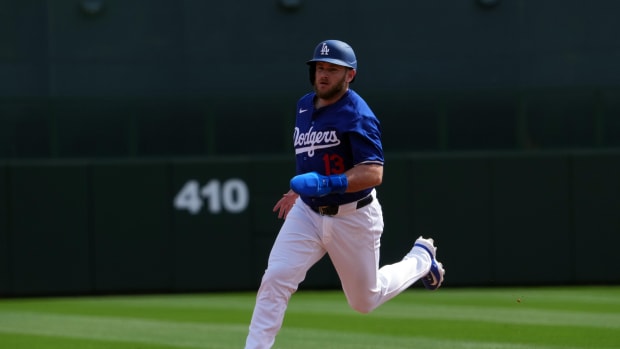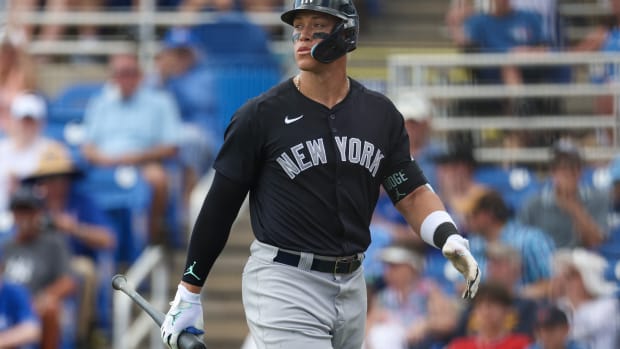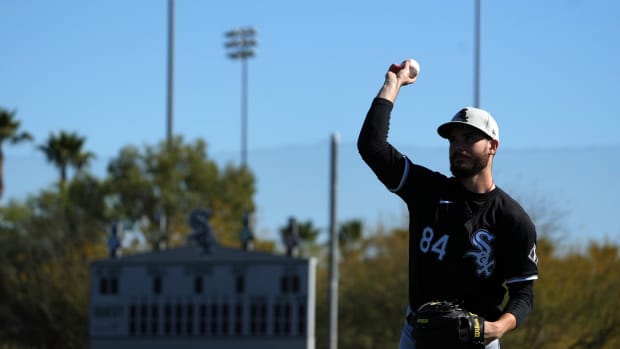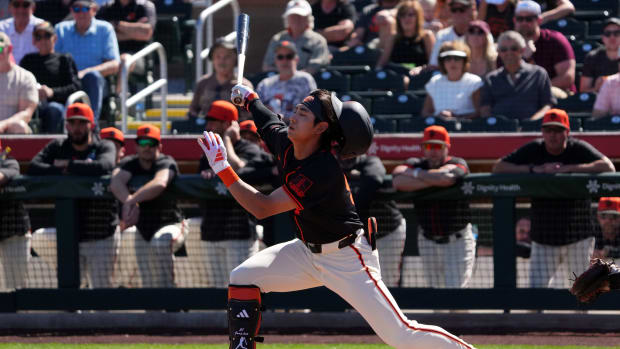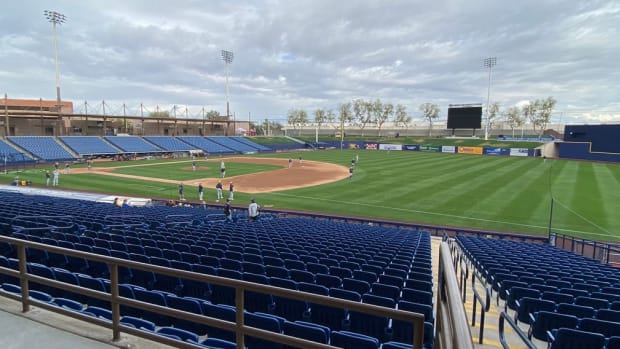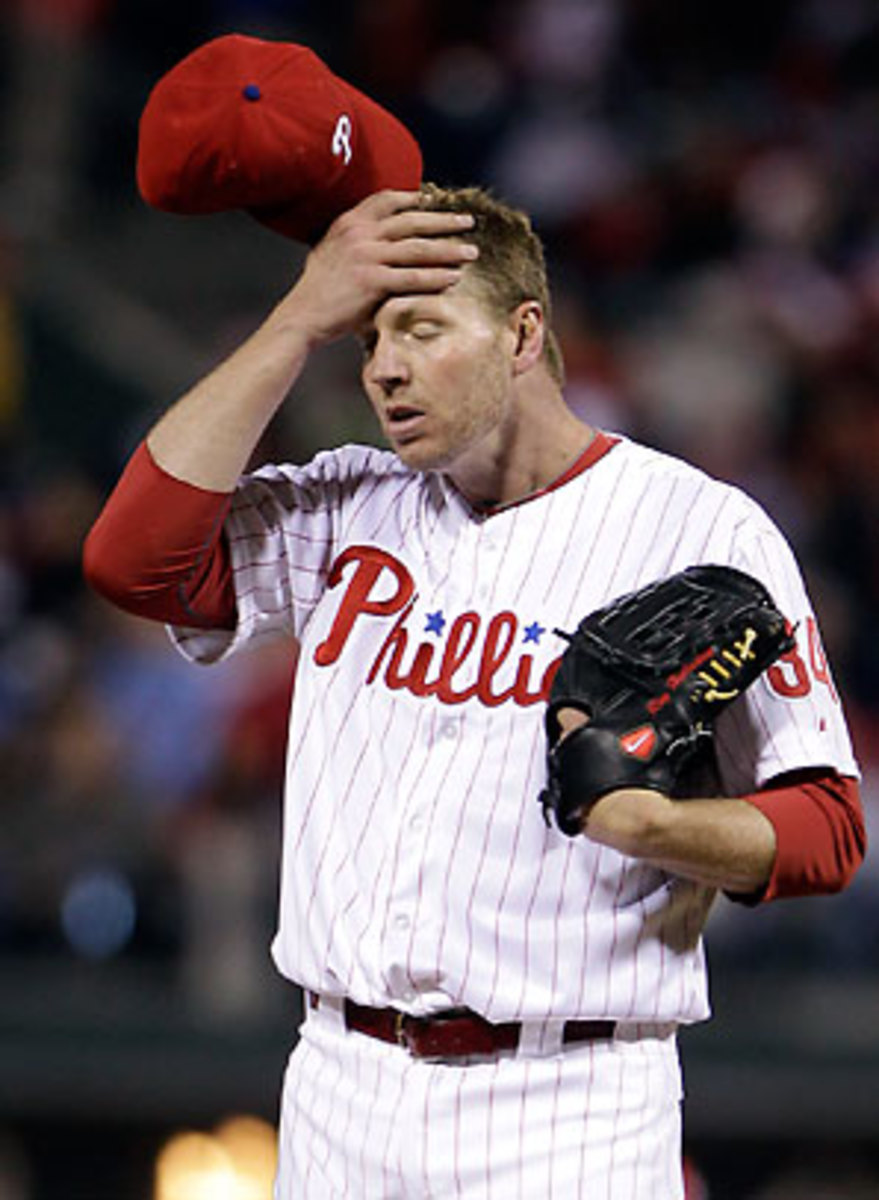
Few good options for Phillies
Roy Halladay's struggles have been a big part of the Phillies' surprisingly slow start. (AP)
A rough season for the Phillies just got a lot rougher, as Roy Halladay is headed to the disabled list for 6-8 weeks because of a strained right shoulder.
Halladay's injury is a surprise, given that the two-time Cy Young winner has long been among the most durable pitchers in baseball. Even after he exited his start on Sunday after just two innings because of shoulder soreness, his 72 1/3 innings this year was tops in the National League, and since the beginning of 2006, nobody has thrown more innings than his 1,487 (CC Sabathia at 1,463 and Dan Haren at 1,429 are the only pitchers within 100 innings). He hasn't been on the disabled list for an arm-related injury since 2004, when a shoulder strain cost him two months (though he missed the second half of 2005 due to a broken leg), and has averaged 32 starts per year from 2006-11.
Even so, it's been clear that the 35-year-old Halladay has not been his normal excellent self. Through 11 starts, his 3.98 ERA is about three-quarters of a run higher than his career mark — and his highest since 2004 — following back-to-back starts in which he allowed a total of nine runs in eight innings. His home run rate has nearly doubled relative to last season, from 0.39 per nine to a still-impressive 0.75, and while his strikeout and walk rates (7.0 and 1.7 per nine, respectively) are just whiskers away from his career marks, they would represent his worst since 2007.
Underlying those numbers, Halladay's average fastball velocity has deteriorated from 93.7 MPH in 2009 to 91.6 this season, according to the park-adjusted data at BrooksBaseball.net, and he's throwing more curveballs and fewer fastballs than before. Pitching coach Rich Dubee has noted that he hasn't been getting his typical movement on pitches, that he hasn't been executing those pitches consistently and that his "cranky shoulder" has been a lingering issue, a constellation of symptoms that are likely tied together. The PITCHf/x data suggests his release point has been slightly lower, though Will Carroll noted that the general trend is for aging pitchers to remain more upright.
Halladay's absence leaves the Phillies with "only" two ace-caliber pitchers in Cole Hamels and Cliff Lee, but even so, the team is already facing an uphill battle. The five-time defending NL East champions enter Tuesday tied for fourth place in the division and, at 26-24, just two games above .500. With both Ryan Howard and Chase Utley yet to play a game this year due to injuries, their offense has been held together by duct tape, Carlos Ruiz (.366/.419/.592) and Juan Pierre (.314/.354/.350); the team's 4.16 runs per game ranks seventh in the NL, 0.02 above the league average. The bullpen has the league's second-worst ERA (4.65), and that's not even including their league-worst rate of allowing inherited runners to score (43 percent). It's their rotation, which ranks third in ERA (3.35) and first in quality start rate (70 percent) and innings per start (6.6) — softening the blow from that bullpen just a bit — that's kept them afloat.
Even so, the rotation's depth is already being tested. Lee lost three weeks due to an oblique strain earlier this season, and Vance Worley went on the disabled list two weeks ago due to inflammation caused by bone chips in his elbow, pressing swingman Kyle Kendrick into starting duty yet again. Worley is playing long-toss and hoping to throw a bullpen session this week, but it may be three weeks before he's back in the fold. If Halladay goes on the disabled list, a retread such as David Bush, Scott Elarton, or Pat Misch is the likely patch. All are currently in Triple-A Lehigh Valley's rotation, and all are the definition of replacement level, having more or less pitched their way out of the majors in recent years.
Bush (4.70 career ERA) threw just 37 1/3 innings of 5.79 ERA ball for the Rangers in 2011, Misch (4.80 career ERA) lasted just seven innings with last year's Mets and Elarton (5.29 career ERA) last appeared on the big league scene with Cleveland in 2008 and didn't pitch anywhere last year. Twenty-five-year-old righty Tyler Cloyd is the minor league system's hottest pitcher (2.01 ERA and 7.0 strikeouts per nine in 10 starts split between Double-A and Triple-A), but Baseball America didn't even consider him among the team's top 30 prospects at the outset of the season, and that's in an organization that itself ranked 27th out of 30.
Beyond those less-than-stellar options, one name from outside the organization stood out: Roy Oswalt, who pitched for the Phils in late 2010 and 2011 but decided to wait until the season was underway before choosing a destination. On Tuesday afternoon, just as news of Halladay's DL trip was being announced, came reports that Oswalt would be signing with the Texas Rangers. In a matter of minutes the news for Philadelphia went from bad to worse.































